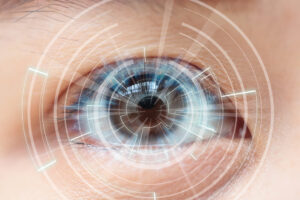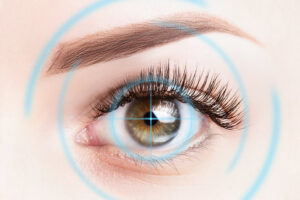
Some might think they are purely cosmetic, but our eyelashes serve various purposes for our eyes. They help keep dust and debris out of the way and from entering the eye. They can sense touch and trigger the protective blink reflex. And, of course, they also add a cosmetic appeal to our facial characteristics.
Still, they can also be a source of issues, especially in the case of distichiasis and trichiasis.
The latter is the condition of ingrown eyelashes, or more precisely, a condition in which the lashes grow toward the eye.
On the other hand, distichiasis is another form of eyelash abnormality, where an extra set of lashes grow behind the regular set. These extra lashes also tend to grow inward, often resulting in the need for eyelash removal.
As you might have guessed, in this article, we’ll discuss these eyelash issues and their treatments. If you feel that you want to learn even more about these conditions after reading this article and you are in the area, feel free to schedule an eye exam in New Jersey, where we can also address your concerns regarding distichiasis and trichiasis.
Eyelash in the Eyes
In both cases, the lashes can reach the eye’s surface, causing either intermittent or continuous rubbing and discomfort. Besides being bothersome, the lashes in the eye can also cause potential damage, as the rough lashes can cause more than mild discomfort. Ingrown eyelashes can even lead to infection and even permanent damage from scarring, which can even potentially end in vision loss.
Trichiasis Causes

Unfortunately, the medical and scientific community doesn’t have a conclusive answer to what actually causes these conditions in every case. More specifically, there are instances where the source of the problem can be identified, but there are also several isolated cases without known causes. Still, after eyelash removal, the problem will be permanently solved.
On the other hand, trichiasis also has known causes, and below are the most common cases:
- Hereditary conditions: Some people will have misdirected lashes from birth. Also, they may develop ingrown eyelashes later in life.
- Injury: in some cases, scar tissue may develop in the area after injury, which causes the lashes to grow inward.
- Surgery: Like in the case of trauma, the scar tissue that may develop after eyelid surgery can cause the lashes to grow in the eye’s direction.
- Inflammation: Several conditions may lead to scarring and inflammation that may lead to trichiasis. Bacterial, viral infections, burns, trauma, blepharitis, and autoimmune diseases are just a few of them.
- Entropion: An eye condition similar to trichiasis, where the eyelids turn inward in the eyes direction, also causing the eyelashes to turn toward the eye.
- Trachoma: A bacterial infection that causes scarring inside the eyelids and leads to ingrown eyelashes.
Trichiasis Symptoms
The most common symptoms of ingrown eyelashes are:
- The feeling as though a foreign object or body is in your eye
- Redness in the eye
- Watery or itchy eyes
- Light sensitivity
- Discharge from the eyes
- Blurred vision
- Sharp eye pain.
Trichiasis Treatment
Regarding treatment options, procedures range from simple approaches to more intricate surgeries, like eyelash removal.
The initial treatment will usually be removing the lashes that grow inward at a slit lamp with the help of a forceps. However, this is only temporary, as the lashes will eventually grow back in about 4 to 6 weeks.
Depending on the patient’s choice or the doctor’s recommendation, patients can undergo this treatment every 4-6 weeks, or they can opt for permanent eyelash removal.
In the latter case, several methods are available, and the best approach will be determined based on the number and the location of the inward-growing hairs.
That said, eyelash removal options include the following:
- Radiofrequency Ablation: This treatment uses heat and radio waves to eliminate the lash follicle
- Micro-Cauterization: Experts use a heated microscopic cautery tip to eliminate the lash follicle at the slit lamp. This eyelash removal approach is considered very effective, even if, in some cases, experts might need a couple of sessions to remove the inward-growing lashes permanently.
- Laser Cauterization: Similar to micro-cauterization, a laser is used to destroy the lash follicle.
- Surgical Excision: This surgery is effective when the doctors need to deal with a larger area of ingrown lashes.
- Cryoablation: This trichiasis treatment is also used when there are simply too many misdirected lashes. In the case of cryoablation, the eyelashes in the eye are frozen, so they can’t regrow. Following the procedure, patients will experience discomfort and swelling for a day or two. The only problem is that with cryoablation, even some of the healthy lashes can be removed along with the ingrown ones.
Dealing With Ingrown Eyelashes
When patients think they may have trichiasis, they should visit a trained eye specialist as soon as possible to treat the condition before it can lead to more severe or even permanent damage.
If corrected in time, ingrown lashes usually won’t lead to concerning complications.
During the appointment, the eye specialist will examine their condition and determine whether they are dealing with distichiasis or trichiasis. During the examination, the specialist will also be able to determine the state of the condition and whether the lashes have already caused damage to the eyes buy spotify plays. Also, the eye specialist will help with recommending the best course of action for addressing the problem as well as give guidance regarding eye and vision protection going forward.
Ingrown Eyelash Treatment – What You Should Know About The Procedures
If you have questions or concerns regarding these procedures, you should know the following:
- For the most part, the surgeries that correct this condition will usually take less than 15 to 20 minutes for each eye.
- Patients who undergo these procedures are usually administered a local anesthetic, and the discomfort they might experience after the procedure will only be short-lived, dissipating in one or two days.
- The surgery is performed on the eyelid and not on the eyeball.
- Patients are free to go home one or two hours after they’ve had surgery.
- Patients are usually able to get back to their everyday schedule the very next day following surgery or even the same day in some cases.
Avoiding Infection

As we’ve discussed, infections can serve as a major trigger for trichiasis. As such, you can follow the guidelines below to avoid them:
- Whenever taking out or putting in your contacts, wash your hands.
- Stay away from eyelash curlers because you can curl the lashes in the opposite way. If your lashes already curl downward, curlers can only cause more problems.
- Avoid fake eyelashes. They stick the lash line with glue containing formaldehyde, that’s known to cause allergic reactions and irritation.
- Clean all your makeup brushes at least once a week with warm water and gentle soap, then let them air dry.
- Stay away from sharing makeup.
- Always wash off any makeup before going to bed.
Timely Reaction is Key
When it comes to treating trichiasis, reacting as soon as possible is pivotal to avoid potentially permanent damage to the eyes and your vision. If you think that you might be dealing with these conditions, feel free to reach out to us or book an appointment. Our experts will make sure to address the issue and help you return to your everyday life as quickly as possible.
Contact Us
If you have more questions about LASIK procedures, get in touch with us.
Related Blogs

Timing is Everything: When to Consider LASIK After Nursing for Optimal Results
Timing is everything when considering LASIK eye surgery after nursing, and understanding the optimal period for this procedure is vital for both mother and baby.

Cataract Surgery: Restoring Clarity and Confidence
Cataract surgery is a transformative procedure that offers a new lease on clear vision and renewed confidence. As cataracts cloud the eye’s lens, causing blurred

Intralase LASIK Explained: What to Expect Before, During, and After the Procedure
Intralase LASIK is a cutting-edge procedure that offers a safe, effective, and precise way to enhance vision compared to traditional LASIK methods. Understanding what to
